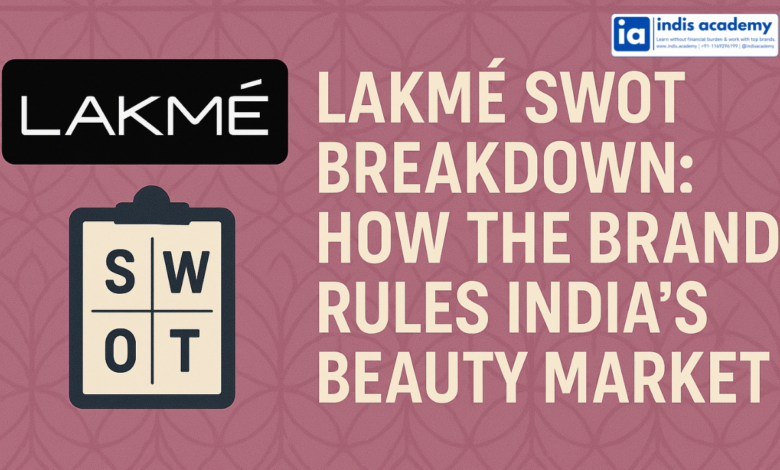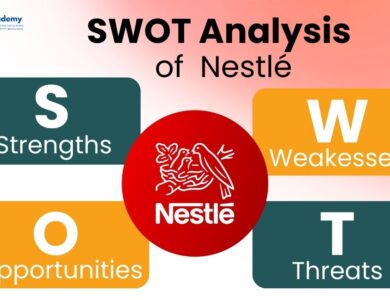Lakmé SWOT Breakdown: How the Brand Rules India’s Beauty Market

When it comes to beauty in India, Lakmé is more than just a brand—it’s a household name, a runway staple, and a symbol of elegance that has stood the test of time. For over seven decades, Lakmé has shaped the way Indian consumers perceive makeup and skincare, blending affordability with aspiration like no other brand in the country.
From the glossy pages of fashion magazines to everyday vanity kits, Lakmé has managed to stay relevant in a market now flooded with both local and global competitors. But what keeps Lakmé on top? And where does it need to evolve?
In this article, we’ll take a closer look through a SWOT analysis of Lakmé—uncovering its Strengths, Weaknesses, Opportunities, and Threats in the ever-evolving beauty industry. Whether you’re a marketing student, business enthusiast, or beauty lover, this breakdown offers a strategic peek into how Lakmé continues to rule India’s beauty market—one product launch at a time.
Learn AI & Digital Marketing,
Pay Fees After Placement
- ✅ Minimal Admission Fees
- ✅ No Loan or Income Sharing Agreement
- ✅ 100% Placement Support
- ✅ ISO & Govt Registered Certificate
- ✅ Practical 3+1 Months Duration
Get a free counseling call. We’ll guide you through learning, certification, and job placement.
Request a Free Call Back
Takes less than a minute.
Brand Overview of Lakmé
Lakmé was born in 1952, a time when Indian women had limited access to high-quality, affordable cosmetics. Established by Tata Group and later acquired by Hindustan Unilever Limited (HUL), Lakmé became India’s first homegrown beauty brand, combining international quality with Indian sensibilities.
Today, Lakmé stands tall as a market leader in the Indian cosmetics and personal care segment, offering a wide range of products—from foundations, lipsticks, and eyeliners to skincare, sunscreens, and salon services. The brand caters to a diverse audience with mass-market affordability and premium collections like Lakmé Absolute and 9 to 5.
Lakmé is not just a cosmetics company—it’s a fashion statement. Its association with the glamorous Lakmé Fashion Week, celebrity endorsements, and influencer collaborations have helped it stay culturally relevant while continually expanding its consumer base.
With more than 1,400 Lakmé salons across India and a rapidly growing e-commerce presence, the brand continues to redefine beauty for modern Indian consumers.
Quick Comparison: Lakmé vs Key Competitors
| Brand | Parent Company | Key Focus | Market Position |
|---|---|---|---|
| Lakmé | Hindustan Unilever | Mass + Premium Cosmetics, Salons | India’s #1 homegrown brand |
| Maybelline | L’Oréal | Global, Trendy Makeup | Strong urban presence |
| Sugar Cosmetics | Independent (D2C) | Bold, Gen Z appeal, online-first | Fast-growing Indian startup |
| Mamaearth | Honasa Consumer Ltd. | Natural & toxin-free personal care | Trending with millennials |
| MyGlamm | The Good Glamm Group | D2C Beauty + Content | Digital-first beauty disruptor |
What is SWOT Analysis?
A SWOT analysis is a strategic planning tool used to evaluate a brand’s current position by examining four key areas:
- S – Strengths: What the brand does well internally
- W – Weaknesses: Areas where it struggles or underperforms
- O – Opportunities: Market trends or external factors it can leverage
- T – Threats: Risks or challenges from competitors or the environment
For a legacy brand like Lakmé, which operates in a fast-evolving and competitive beauty landscape, SWOT analysis helps uncover how it continues to lead, where it lags, and what it must do to stay relevant.
Whether you’re analyzing Lakmé as a business case study or tracking brand performance in the Indian beauty industry, this framework offers clear, actionable insights into the brand’s current and future potential.
Lakmé’s Strengths
Over the decades, Lakmé has built a strong foundation in the Indian beauty space by combining innovation, cultural relevance, and wide accessibility. Let’s explore the key strengths that make Lakmé a market leader:
💪 1. Powerful Brand Legacy
Founded in 1952, Lakmé has over 70 years of trust and recognition in India. It was the first Indian brand to make beauty products affordable and accessible to Indian women—giving it a deep emotional and historical connection with consumers.
🎯 2. Wide Product Portfolio
From affordable everyday products to high-end cosmetic lines like Lakmé Absolute and 9 to 5, the brand offers makeup, skincare, sun protection, and salon services—catering to both mass and premium segments.
🛍️ 3. Extensive Offline & Online Distribution
Lakmé products are available in over 2,000 cities, across retail stores, supermarkets, Lakmé salons, and all major e-commerce platforms including Nykaa, Amazon, and Flipkart. This wide presence ensures strong visibility and availability.
💅 4. Strong Fashion Association
Lakmé Fashion Week, one of India’s biggest fashion events, positions the brand as aspirational and trend-setting. This association boosts brand image and aligns it with glamour, modernity, and style.
🤝 5. Backed by Hindustan Unilever (HUL)
As a part of HUL, Lakmé enjoys access to advanced R&D, advertising budgets, and supply chain excellence, giving it a major operational edge over smaller competitors.
📱 6. Strong Digital and Influencer Presence
Lakmé leverages influencer marketing and social media campaigns to reach younger audiences. Its collaborations with celebrities and content creators keep it top-of-mind for digital-first consumers.
These strengths allow Lakmé to dominate both traditional and modern beauty segments, while evolving with changing consumer needs.
Lakmé’s Weaknesses
Despite being a legacy brand with wide recognition, Lakmé isn’t without its internal challenges. These weaknesses, if not addressed, could impact its ability to stay ahead in an industry driven by rapid innovation and changing consumer preferences.
⚠️ 1. Perception as an “Old-School” Brand
While Lakmé is trusted, younger consumers sometimes see it as traditional or outdated, especially when compared to bolder, trendier D2C brands like Sugar Cosmetics or MyGlamm that resonate more with Gen Z.
⚠️ 2. Slower Product Innovation
In a market where beauty trends change monthly, Lakmé has been relatively slower to launch cutting-edge formulas or viral-worthy products, which can affect relevance in the trend-focused digital beauty space.
⚠️ 3. Limited Global Presence
Unlike global giants like Maybelline or L’Oréal, Lakmé’s footprint is mostly India-centric, with limited visibility or recognition in international markets.
⚠️ 4. Overcrowded Product Lines
While having variety is a strength, too many similar SKUs can cause confusion for consumers and make it harder for flagship products to stand out.
⚠️ 5. Reliance on Offline Retail & Salons
Although Lakmé has grown online, it still leans heavily on brick-and-mortar retail and salons. With the rise of online-only beauty brands and D2C models, this could become a limitation in the long term.
By addressing these areas, Lakmé can enhance its appeal to younger audiences and adapt faster to the evolving beauty industry landscape.
Lakmé’s Opportunities
The Indian beauty and personal care market is booming, and Lakmé is perfectly positioned to expand its influence—if it continues to innovate and adapt. Let’s explore the top opportunities the brand can leverage:
🌿 1. Rising Demand for Natural & Clean Beauty
Consumers are becoming more conscious of what goes on their skin. Lakmé can capitalize on this by introducing organic, paraben-free, and cruelty-free product lines that compete with brands like Mamaearth and Plum.
🧴 2. Growth in Men’s Grooming & Unisex Skincare
The male grooming segment is growing rapidly in India. Lakmé can explore gender-neutral or men-specific skincare and makeup lines to tap into a less-saturated but fast-growing space.
📱 3. Direct-to-Consumer (D2C) Expansion
With rising smartphone and e-commerce usage, Lakmé has the opportunity to build its own D2C platform, offer exclusive online products, and create personalized shopping experiences powered by AI and virtual try-ons.
🧑💼 4. Expansion in Tier-2 & Tier-3 Cities
As beauty awareness increases in smaller towns, Lakmé can lead by launching affordable product bundles, regional marketing, and pop-up experiences—targeting the aspirational rural youth segment.
💇 5. Scaling Lakmé Salon Franchise
Lakmé already has 1,400+ salons across India. With the right tech integration and localized services, this can grow into a powerful lifestyle ecosystem for skincare, hair, makeup, and bridal services.
By embracing these opportunities, Lakmé can evolve into a future-ready, digitally strong, and inclusive beauty powerhouse—without losing the charm of its legacy.
Lakmé’s Threats
While Lakmé holds a powerful position in India’s beauty market, it faces several external threats that could impact its growth, relevance, and long-term brand loyalty.
⚠️ 1. Intense Market Competition
The Indian beauty space is becoming increasingly crowded with digital-first brands like Sugar, Mamaearth, MyGlamm, and international giants like Maybelline, L’Oréal, and Huda Beauty. These brands often launch faster, innovate more frequently, and are highly active on social media, posing a direct threat to Lakmé’s market share.
⚠️ 2. Rapidly Changing Consumer Preferences
Today’s consumers expect clean, vegan, cruelty-free, and ingredient-transparent products. If Lakmé doesn’t match this pace, it risks being perceived as outdated by Gen Z and millennial buyers.
⚠️ 3. Digital Reputation Risks
In the social media age, a single influencer’s negative review or a viral controversy can quickly damage years of brand equity. Beauty brands are especially vulnerable to online backlash regarding product quality, pricing, or ethical practices.
⚠️ 4. Pricing Pressure from New-Age Brands
Many indie and homegrown startups offer similar-quality products at more affordable prices with modern branding. This puts Lakmé in a tricky spot where it has to justify its pricing while staying competitive.
⚠️ 5. Regulatory and Sustainability Pressures
Tighter cosmetic safety regulations and sustainability mandates are forcing beauty brands to reformulate and rethink packaging. Lakmé must be proactive to stay compliant and eco-friendly.
To stay ahead, Lakmé needs to remain agile, invest in innovation, and deepen its digital presence—all while listening closely to the evolving voice of its consumer.
How Lakmé Maintains Its Leadership
Despite rising competition and changing trends, Lakmé continues to hold its crown as India’s most recognized beauty brand. Here’s how it strategically maintains that leadership in a fast-evolving market:
👑 1. Balancing Mass and Premium Appeal
Lakmé’s ability to offer products for every budget — from everyday kajals to high-performance foundations — gives it a wider consumer base than most competitors. This balance ensures reach in both Tier-1 metros and Tier-3 towns.
🎨 2. Strong Fashion & Cultural Integration
By owning Lakmé Fashion Week, the brand keeps its association with glamour, modernity, and high fashion alive. It’s not just selling products — it’s selling aspiration, lifestyle, and artistry.
💡 3. Celebrity & Influencer Marketing
From top Bollywood faces to regional influencers, Lakmé uses smart partnerships to maintain top-of-mind recall across platforms like Instagram, YouTube, and TV ads — reaching both urban youth and traditional audiences.
💅 4. Lakmé Salon Network as a Brand Touchpoint
With 1,400+ salons, Lakmé offers an experiential layer to the brand. Customers can test products, get beauty services, and form long-term relationships with the brand beyond just retail purchases.
🧠 5. Backed by HUL’s Innovation Engine
Being part of Hindustan Unilever gives Lakmé access to world-class R&D, packaging, data insights, and retail infrastructure, helping it scale quickly and efficiently.
Through a combination of brand nostalgia, innovation, fashion influence, and operational strength, Lakmé stays deeply embedded in the Indian beauty consumer’s life — and in their makeup pouch.
Conclusion & Final Thoughts
Lakmé isn’t just a brand — it’s an emotion, a part of growing up, and for many, a first step into the world of beauty. From timeless products to glamorous fashion events, Lakmé has shaped India’s beauty narrative for over seven decades.
This SWOT analysis of Lakmé reveals a brand that’s rooted in legacy but actively evolving. With its strong market presence, wide product portfolio, and deep consumer trust, Lakmé continues to dominate the Indian beauty space. But in a world driven by social trends, clean beauty, and digital-first competition, the brand must stay agile, innovative, and inclusive.
By embracing opportunities in natural beauty, men’s grooming, tier-3 cities, and direct-to-consumer channels, Lakmé can not only defend its crown — but redefine what beauty means for a new generation of consumers.
What’s your take on Lakmé’s future?
💬 Tell us your favorite Lakmé product or what you’d love to see the brand launch next in the comments below!





